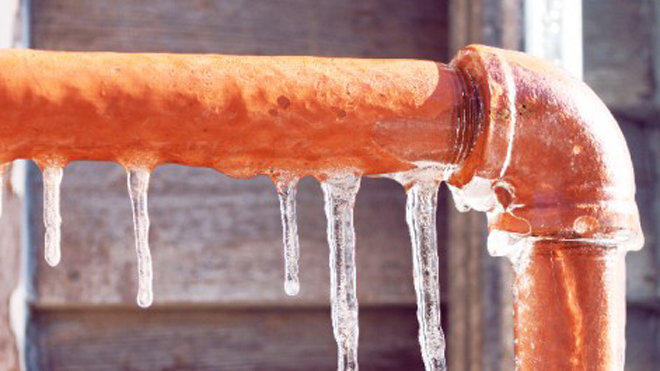Prevent Frozen Pipes in Winter: Pro Tips
Prevent Frozen Pipes in Winter: Pro Tips
Blog Article
They are making a number of good observations about Helpful Tips to Prevent Frozen Pipes this Winter overall in this content just below.

Cold weather can ruin your plumbing, specifically by freezing pipes. Below's how to avoid it from happening and what to do if it does.
Introduction
As temperature levels drop, the danger of icy pipes boosts, possibly leading to expensive fixings and water damage. Comprehending just how to stop frozen pipelines is crucial for house owners in chilly climates.
Prevention Tips
Protecting vulnerable pipes
Cover pipes in insulation sleeves or make use of heat tape to safeguard them from freezing temperature levels. Concentrate on pipelines in unheated or external locations of the home.
Heating techniques
Keep indoor rooms sufficiently heated, particularly locations with plumbing. Open up closet doors to allow cozy air to distribute around pipelines under sinks.
How to recognize icy pipes
Look for lowered water flow from taps, unusual smells or noises from pipes, and visible frost on revealed pipes.
Long-Term Solutions
Structural changes
Consider rerouting pipes away from exterior walls or unheated areas. Add added insulation to attic rooms, cellars, and crawl spaces.
Updating insulation
Buy high-quality insulation for pipelines, attic rooms, and walls. Proper insulation helps keep constant temperature levels and lowers the risk of frozen pipes.
Protecting Outdoor Pipes
Garden hoses and exterior faucets
Disconnect and drain pipes garden hoses prior to winter season. Mount frost-proof spigots or cover outdoor taps with shielded caps.
Recognizing Frozen Pipes
What triggers pipelines to ice up?
Pipelines ice up when exposed to temperatures listed below 32 ° F (0 ° C) for prolonged durations. As water inside the pipes freezes, it expands, taxing the pipeline walls and possibly creating them to break.
Risks and damages
Frozen pipes can result in water system disturbances, home damage, and expensive repair work. Burst pipes can flooding homes and create substantial structural damage.
Indicators of Frozen Piping
Recognizing frozen pipes early can stop them from breaking.
What to Do If Your Pipes Freeze
Immediate activities to take
If you presume frozen pipelines, maintain taps open to relieve stress as the ice melts. Make use of a hairdryer or towels taken in hot water to thaw pipes slowly.
Conclusion
Stopping frozen pipelines calls for aggressive actions and quick feedbacks. By understanding the causes, indications, and safety nets, home owners can protect their plumbing throughout cold weather.
5 Ways to Prevent Frozen Pipes
Drain Outdoor Faucets and Disconnect Hoses
First, close the shut-off valve that controls the flow of water in the pipe to your outdoor faucet. Then, head outside to disconnect and drain your hose and open the outdoor faucet to allow the water to completely drain out of the line. Turn off the faucet when done. Finally, head back to the shut-off valve and drain the remaining water inside the pipe into a bucket or container. Additionally, if you have a home irrigation system, you should consider hiring an expert to clear the system of water each year.
Insulate Pipes
One of the best and most cost-effective methods for preventing frozen water pipes is to wrap your pipes with insulation. This is especially important for areas in your home that aren’t exposed to heat, such as an attic. We suggest using foam sleeves, which can typically be found at your local hardware store.
Keep Heat Running at 65
Your pipes are located inside your walls, and the temperature there is much colder than the rest of the house. To prevent your pipes from freezing, The Insurance Information Institute suggests that you keep your home heated to at least 65 degrees, even when traveling. You may want to invest in smart devices that can keep an eye on the temperature in your home while you’re away.
Leave Water Dripping
Moving water — even a small trickle — can prevent ice from forming inside your pipes. When freezing temps are imminent, start a drip of water from all faucets that serve exposed pipes. Leaving a few faucets running will also help relieve pressure inside the pipes and help prevent a rupture if the water inside freezes.
Open Cupboard Doors
Warm your kitchen and bathroom pipes by opening cupboards and vanities. You should also leave your interior doors ajar to help warm air circulate evenly throughout your home.

Hopefully you liked our piece on How To Avoid Freezing Pipes. Thank you for taking a few minutes to read our piece of content. Do you know somebody who is in the market for the subject? Be sure share it. We take joy in reading our article about Helpful Tips to Prevent Frozen Pipes this Winter.
Call Today Report this page